
SHORIN RYU SHORINKAN...A legacy of great Karate!
When you join our dojo you get to learn of the most prestigious and authentic forms of Okinawan Karate found in the world! Shorin Ryu Shorinkan has a long legacy of being handed down from the very early early pioneers of the Okinawan martial art systems. The system we teach is one of the oldest in the world with an impeccable lineage dating back to the development of Karate systems. Shorinkan's founder, Shugoro Nakazato Hanshi, is recognized by the government of Japan as an "Intangible Cultural Asset" for his dedication and preservation of Okinawan Karate. Read on to learn more about the style you will be learning and discover the roots of where our Karate came from.
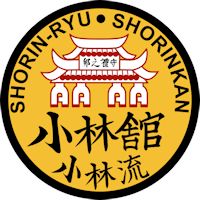 The
Shorin Ryu Shorinkan Patch is one of the most recognized ones in the
world today. Many great martial artists have began their training our
style including quite a few World Champions, Pioneers of Martial Arts in
the United States and many Military Combative Instructors. Our
patch is circular, like many others, to represent the full circle of
martial arts training from student to teacher and back to student again.
Everything in Karate, from techniques to applications, move in a
circular pathway. The Japanese writing on the bottom reads "Shorin Ryu"
which means Small Pine Forrest and the larger Kanji above it reads "Shorin
Ryu Shorin" which means "Small Pine Forrest Home". Early development of
Karate had influences from Chinese Martial Arts, Japanese Jujutsu and
the original Okinawan martial art of "Ti". "Shorin" in Japanese means
the same thing as "Shaolin" in Chinese which is paying tribute to the
aspects that were mixed in with "Ti" to develop Karate from the Shaolin
Martial Arts. Inside the red and white Shuri Gate, known as a "Shureimon"
is some smaller Kanji that reads "Shu Rei no Kuni" that translates to
the "Land of Propriety". The gate on the patch represents the main gate
leading to Shuri Castle in OKinawa which tribute to the many bodyguards
of the Royal Family that developed our style of Karate.
The
Shorin Ryu Shorinkan Patch is one of the most recognized ones in the
world today. Many great martial artists have began their training our
style including quite a few World Champions, Pioneers of Martial Arts in
the United States and many Military Combative Instructors. Our
patch is circular, like many others, to represent the full circle of
martial arts training from student to teacher and back to student again.
Everything in Karate, from techniques to applications, move in a
circular pathway. The Japanese writing on the bottom reads "Shorin Ryu"
which means Small Pine Forrest and the larger Kanji above it reads "Shorin
Ryu Shorin" which means "Small Pine Forrest Home". Early development of
Karate had influences from Chinese Martial Arts, Japanese Jujutsu and
the original Okinawan martial art of "Ti". "Shorin" in Japanese means
the same thing as "Shaolin" in Chinese which is paying tribute to the
aspects that were mixed in with "Ti" to develop Karate from the Shaolin
Martial Arts. Inside the red and white Shuri Gate, known as a "Shureimon"
is some smaller Kanji that reads "Shu Rei no Kuni" that translates to
the "Land of Propriety". The gate on the patch represents the main gate
leading to Shuri Castle in OKinawa which tribute to the many bodyguards
of the Royal Family that developed our style of Karate.
Okinawan Karate dates back to the 6th century with the founding of the Shaolin temple and Chuan Fa (Chinese Martial Arts). Through cultural exchanges and trade, the Okinawans learned martial arts methods and began to meld them into their own indigenous martial art known as "Uchinda Ti". There were three main schools of Ti which included Naha-Te, Shuri-Te and Tomari-Te. These names reflect the villages in which they originated in but it is important to note that the teachings of these schools often melded together in the early times.
Defining aspects found in Shorin Ryu include a heavy emphasis on Self-Defense over the typical sport type of Karate found in most places today. Seeing has how Shorin Ryu was developed by those responsible for the protection and safety of the Royal Family on Okinawa, it makes perfect sense that the main goal would self protection. Our movements, techniques and applications are also more natural and we do not do deep stances or locking out of our techniques as many other schools emphasize. This creates a martial art training environment that is preferred by adults wanting to learn Karate since is allows longevity for the practitioner without damaging their joints. In our dojo we maintain the traditional aspects associated with learning Karate but are not militant in our methods. The culture of dojo is one where everyone supports each other and we share the common goal of all growing in our Karate together. When we train we are not in competition with anyone else in dojo except our own self.
DOES LINEAGE MATTER
IN KARATE?
Yes, where your Karate comes from makes a BIG difference!
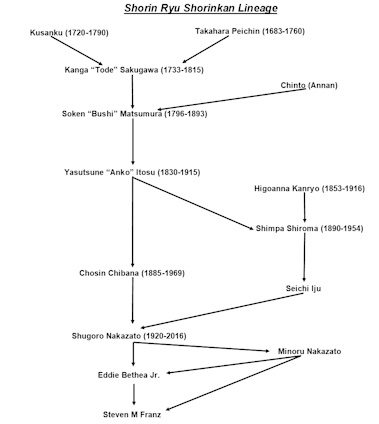
When a person begins to look into a martial art they will be studying they often overlook one of the most important aspects of selecting a school...where that system came from. Put simply, the lineage is how the art was handed down in a unbroken line of succession. Each person who trains will be a set generation under the Master of the system and good lineage dates to the earliest of times.
Our students are very fortunate that our lineage dates to the early 1500's. It was Chosin Chibana Sensei who first named the system we teach as Shorin Ryu. Chibana Sensei appointed Shuguro Nakazato as the most senior instructor in Shorin Ryu. Nakazato Hanshi was permitted to open a dojo in Naha, which was rarely done when the head of the system was still alive. It is documented that people came from all Okinawa and Japan, as well as the world, to train under Nakazato Hanshi since he was well known for handing down the Kata exactly as they were created, not to mention his power and in-depth knowledge of old Okinawan Karate called "To-de". Nakazato Hanshi was known by the US Military men who trained with him by the nickname "One Punch Nakazato" which stemmed from his ability to hit anyone with a single blow resulting in ending the fight.
In 1966, Eddie Bethea was stationed in Okinawa. While traveling to the military base he noticed a sign that read "Nakazato Karate Gym". Once processed into the Air Force Base, Bethea Kyoshi jumped on a bus and headed right to the Nakazato dojo. Bethea Kyoshi has trained under Nakazato Hanshi ever since and is currently ranked at 8th degree black belt and is considered one of the foremost experts on Shorin Ryu in the world today. He is also ranked as an 8th degree black belt in Okinawan Kobudo (weapons). Bethea Kyoshi is a first generation student under Nakazato Hanshi and is our own Sensei's (Steven Franz) teacher.
Steven Franz Shihan is a 6th degree black belt and holds a teaching license as Shihan directly from Okinawa which was awarded by Shugoro Nakazato Hanshi and Minoru Nakazato Hanshi, as well as his own Sensei Eddie Bethea Kyoshi. Franz Shihan is a 2nd generation student in Shorin Ryu Shorinkan and repeats trips to Okinawa yearly for training and review at the Shorinkan World Headquarters located in Naha. This lineage means that his students are getting real, authentic Okinawan Karate in its purest form possible, something that truly separates our school from many others in the area.
Some claim that lineage doesn't really matter and that is often because they don't have a direct line to a pure form of martial art which they claim to teach. There is a true difference in commercialized / sport karate and the Dento (traditional) system found in our dojo. Dento Karate focuses on Self-Defense and Self-Improvement over rank and trophies. In our dojo we teach Karate as it was meant to be making your investment in classes a true learning experience from a very valid source.
PHOTOS OF FRANZ SHIHAN TRAINING IN OKINAWA OVER THE YEARS
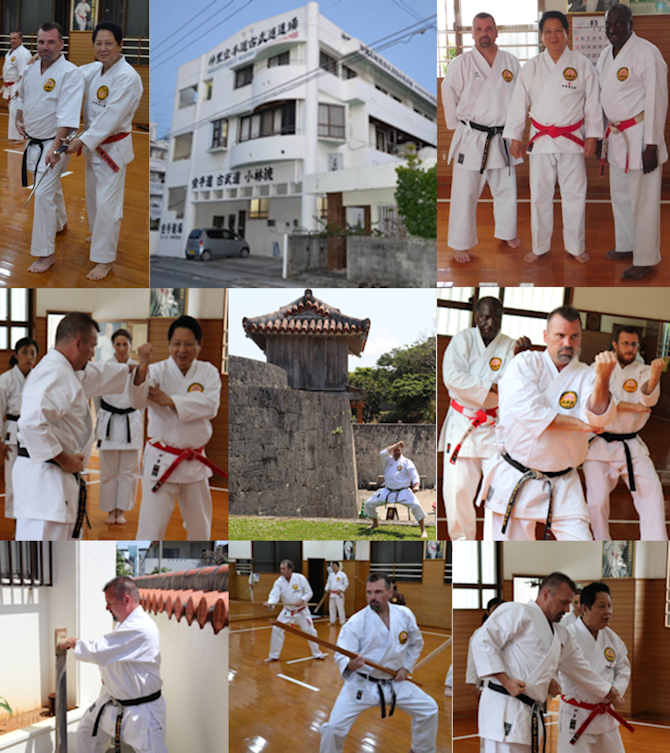
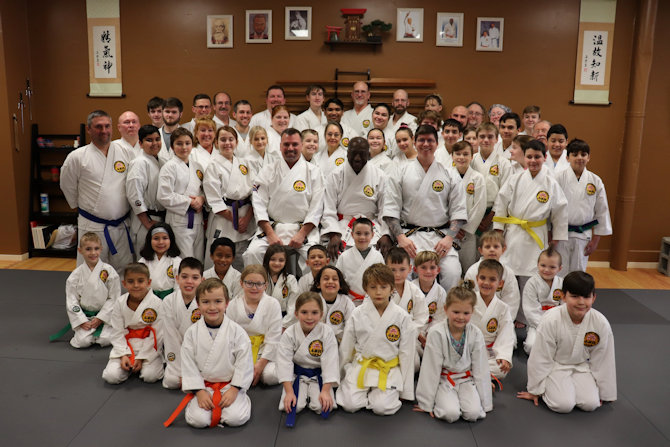

PIONEERS OF OUR KARATE SYSTEM
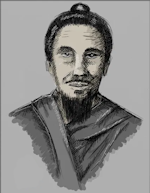 Takahara Peichin (1683-1760) was revered as a great warrior and is
attributed to having been the first to explain the aspects, or
principles of the word "Do" or way in relation to Karate.
These principles were Ijo (compassion), Katsu (deep understanding of
Karate) and Fo (dedication and seriousness). When placed together it
translates to mean "One's duty to himself and fellow man". Most
importantly, he was the first teacher of Sakugawa Kanga "Tode" who would
go on to become known as the "Father of Okinawan Karate". It is said
that Takahara was the first to introduce the Kata of Naihanchi, which is
one of the most famously known in the world.
Takahara Peichin (1683-1760) was revered as a great warrior and is
attributed to having been the first to explain the aspects, or
principles of the word "Do" or way in relation to Karate.
These principles were Ijo (compassion), Katsu (deep understanding of
Karate) and Fo (dedication and seriousness). When placed together it
translates to mean "One's duty to himself and fellow man". Most
importantly, he was the first teacher of Sakugawa Kanga "Tode" who would
go on to become known as the "Father of Okinawan Karate". It is said
that Takahara was the first to introduce the Kata of Naihanchi, which is
one of the most famously known in the world.
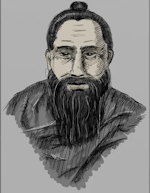 Kusanku (1720-1790) was a Chinese ambassador from the Quing Dynasty. It
was documented that he arrived in Okinawa at the behest of the King in
1761. He resided in the village of Kanemura, near Naha city, and taught
Sakugawa after the death of Takahara Peichin. Kusanku's name is
associated with many of the Kata found in Okinawan Karate, especially
the Shorin Ryu systems. It is documented that Kusanku was from a high
order of military monks with many long years of combative training. He
was living in Okinawa during his later years sharing this knowledge as
Chinese Diplomat.
Kusanku (1720-1790) was a Chinese ambassador from the Quing Dynasty. It
was documented that he arrived in Okinawa at the behest of the King in
1761. He resided in the village of Kanemura, near Naha city, and taught
Sakugawa after the death of Takahara Peichin. Kusanku's name is
associated with many of the Kata found in Okinawan Karate, especially
the Shorin Ryu systems. It is documented that Kusanku was from a high
order of military monks with many long years of combative training. He
was living in Okinawa during his later years sharing this knowledge as
Chinese Diplomat.
 "Tode" Sakugawa (1733-1815) whose family was well noted as experts in
the Okinawan martial art of Te for many generations. Kanga Sakugawa
began learning martial arts from Takahara Peichin. One day, as a younger
man, Sakugawa came across Kusanku standing on a bridge overlooking the
water. Sakugawa was a bit of rebellious young man at this time and
attempted to push Kusanku off the bridge for being in his way as he
crossed it. As he started to push the old man, Kusanku suddenly side
stepped the shove and knocked Sakugawa into the water. Afterwards
Kusanku gave him a strict lecture on the value of respecting one's
elders. It was from this lesson that Sakugawa would always reiterate to
his students that it is important, not just to know the how, but also
the why we study Karate. After spending six years studying under Kusanku,
and upon Kusanku's death, Sakugawa went on to create the first version
of Kusanku Kata named in his honor. This Kata is preserved in our system
to this day. It is also important to note that the Sakugawa family was
famous experts of their ability to use the Bo (long staff). Many of our
Bo Kata and methods are named after their family including the manner in
which we switch grip quickly with the weapon when training. It is
referred to as the "Sakugawa Exchange".
"Tode" Sakugawa (1733-1815) whose family was well noted as experts in
the Okinawan martial art of Te for many generations. Kanga Sakugawa
began learning martial arts from Takahara Peichin. One day, as a younger
man, Sakugawa came across Kusanku standing on a bridge overlooking the
water. Sakugawa was a bit of rebellious young man at this time and
attempted to push Kusanku off the bridge for being in his way as he
crossed it. As he started to push the old man, Kusanku suddenly side
stepped the shove and knocked Sakugawa into the water. Afterwards
Kusanku gave him a strict lecture on the value of respecting one's
elders. It was from this lesson that Sakugawa would always reiterate to
his students that it is important, not just to know the how, but also
the why we study Karate. After spending six years studying under Kusanku,
and upon Kusanku's death, Sakugawa went on to create the first version
of Kusanku Kata named in his honor. This Kata is preserved in our system
to this day. It is also important to note that the Sakugawa family was
famous experts of their ability to use the Bo (long staff). Many of our
Bo Kata and methods are named after their family including the manner in
which we switch grip quickly with the weapon when training. It is
referred to as the "Sakugawa Exchange".
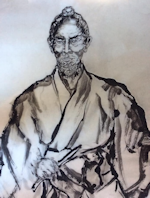 Soken "Bushi" Matsumura (1796-1893) was the first to systemize the Shuri-te art. Shuri-te is the parent martial art that our style of
Karate came from. Born into a prominent family from Shuri village,
Matsumura was highly a educated scholar and very athletic. He learned
the fundamentals of "Te" as a young boy which was customary for upper
class youths at the time. According to many historians, Matsumura began
formal training under Tode Sakugawa. From Sakugawa he is said to have
learned the use of the Bo and the Kata Kusanku. While serving as a
bodyguard, and the martial arts instructor, to the last three Kings of
Okinawa, he made many official visits to China and Japan where he
studied Chinese Boxing and Japanese swordsmanship. Following retirement
from service to the royal family, Matsumura taught Karate in the village
of Shuri. Among his many famous students were Itosu Yatsutsune, Kentsu
Yabu, Chomo Hanashiro, Gichin Funakoshi, Chotoku Kyan and Nabe
Matsumura. Sokon Matsumura is credited with having originated, or having
developed, important variations of many Shorinkan Kata including
Gojushiho, Kusanku Dai, Passai Dai, Chinto, Naihanchi Shodan and Nidan.
Soken "Bushi" Matsumura (1796-1893) was the first to systemize the Shuri-te art. Shuri-te is the parent martial art that our style of
Karate came from. Born into a prominent family from Shuri village,
Matsumura was highly a educated scholar and very athletic. He learned
the fundamentals of "Te" as a young boy which was customary for upper
class youths at the time. According to many historians, Matsumura began
formal training under Tode Sakugawa. From Sakugawa he is said to have
learned the use of the Bo and the Kata Kusanku. While serving as a
bodyguard, and the martial arts instructor, to the last three Kings of
Okinawa, he made many official visits to China and Japan where he
studied Chinese Boxing and Japanese swordsmanship. Following retirement
from service to the royal family, Matsumura taught Karate in the village
of Shuri. Among his many famous students were Itosu Yatsutsune, Kentsu
Yabu, Chomo Hanashiro, Gichin Funakoshi, Chotoku Kyan and Nabe
Matsumura. Sokon Matsumura is credited with having originated, or having
developed, important variations of many Shorinkan Kata including
Gojushiho, Kusanku Dai, Passai Dai, Chinto, Naihanchi Shodan and Nidan.
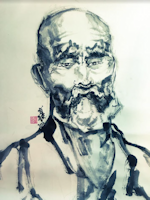 Yasutsune Anko Itosu (1830-1915) is considered on of the greatest
teachers in the history of Karate. Itosu simplified many of the ancient
Katas, created several new ones of his own and pioneered teaching
methods that would revolutionize the art by making its study more
systematic to pass on to generations of future Karateka (students). For
his efforts and a lifetime of dedication to the art he is often referred
to as the "Father of Modern Karate". Born in Shuri village, Itosu began
his training at an early age under Matsumura and subsequently trained
under several other great teachers possible including Kosaku Matsumora
of Tomari. Well educated in Chinese and Japanese literature, Itosu
served as translator to King Sho Tai, the last of the Okinawan Kings,
until his fall from power in 1879. In 1901, Itosu first introduced
Karate into the physical education system of the Okinawan public
schools. This was a crucial step in transforming the public perception
of Karate as a feudalistic fighting method into one which emphasized
health and spiritual well being. Itosu created the Pinan series of Kata
which are practiced across the world today in Karate. He is also
credited with developing Naihanchi Sandan, Passai Sho and Kusanku Sho
Kata. Had Itosu not developed this method of passing on the art of Tode
it is highly unlikely that the Japanese government would have permitted
its preservation due to the changing cultural climate of the reformation
taking place at that time. Military arts were no longer seen as
necessary so many of them were being modified such as Jujitsu to Judo,
Kenjutsu to Kendo and so forth for their preservation. Itosu noted this
and began to work on a manner in which Tode could be accepted and
preserved by the Japanese government. A list of Itosu's students reads
like a who's-who of famous Karate Masters and includes Gichin Funakoshi,
Chomo Hanashiro, Chotoku Kyan, Chosin Chibana, Kentsu Yabu, Choki Motobu,
Kenwa Mabuni and Shigeru Nakamura.
Yasutsune Anko Itosu (1830-1915) is considered on of the greatest
teachers in the history of Karate. Itosu simplified many of the ancient
Katas, created several new ones of his own and pioneered teaching
methods that would revolutionize the art by making its study more
systematic to pass on to generations of future Karateka (students). For
his efforts and a lifetime of dedication to the art he is often referred
to as the "Father of Modern Karate". Born in Shuri village, Itosu began
his training at an early age under Matsumura and subsequently trained
under several other great teachers possible including Kosaku Matsumora
of Tomari. Well educated in Chinese and Japanese literature, Itosu
served as translator to King Sho Tai, the last of the Okinawan Kings,
until his fall from power in 1879. In 1901, Itosu first introduced
Karate into the physical education system of the Okinawan public
schools. This was a crucial step in transforming the public perception
of Karate as a feudalistic fighting method into one which emphasized
health and spiritual well being. Itosu created the Pinan series of Kata
which are practiced across the world today in Karate. He is also
credited with developing Naihanchi Sandan, Passai Sho and Kusanku Sho
Kata. Had Itosu not developed this method of passing on the art of Tode
it is highly unlikely that the Japanese government would have permitted
its preservation due to the changing cultural climate of the reformation
taking place at that time. Military arts were no longer seen as
necessary so many of them were being modified such as Jujitsu to Judo,
Kenjutsu to Kendo and so forth for their preservation. Itosu noted this
and began to work on a manner in which Tode could be accepted and
preserved by the Japanese government. A list of Itosu's students reads
like a who's-who of famous Karate Masters and includes Gichin Funakoshi,
Chomo Hanashiro, Chotoku Kyan, Chosin Chibana, Kentsu Yabu, Choki Motobu,
Kenwa Mabuni and Shigeru Nakamura.
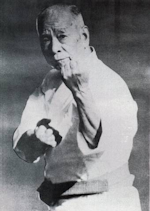 Chosin Chibana (1885-1969) was born June 5 in the Tottori-chi area of
Shuri city. He began training with Yasutsune Anko Itosu in 1900 with
whom he studied until Itosu passed away. In 1920, Chibana opened his
first dojo in Tottori-Bori and later a second dojo in Kumo-cho where he
instructed until he suspended teaching due to the outbreak of World War
II. After war, Chibana resumed formal teaching in Giho-cho, a section of
Shuri city. During the 1950's he maintained his dojo and was the chief
Karate instructor for the Shuri police force. In may of 1956 his
accomplishments were recognized by his appointment as the first
president of the Okinawan Karate Do Association. Chibana's reputation as
a Karate Master continued to spread, not only in Okinawa, but also in
mainland Japan. Prior to his death in Ohama Hospital on February 16,
1969, Chibana Sensei was recognized with honors such as:
Chosin Chibana (1885-1969) was born June 5 in the Tottori-chi area of
Shuri city. He began training with Yasutsune Anko Itosu in 1900 with
whom he studied until Itosu passed away. In 1920, Chibana opened his
first dojo in Tottori-Bori and later a second dojo in Kumo-cho where he
instructed until he suspended teaching due to the outbreak of World War
II. After war, Chibana resumed formal teaching in Giho-cho, a section of
Shuri city. During the 1950's he maintained his dojo and was the chief
Karate instructor for the Shuri police force. In may of 1956 his
accomplishments were recognized by his appointment as the first
president of the Okinawan Karate Do Association. Chibana's reputation as
a Karate Master continued to spread, not only in Okinawa, but also in
mainland Japan. Prior to his death in Ohama Hospital on February 16,
1969, Chibana Sensei was recognized with honors such as:
1957 - Title of Hanshi (high Master) from the Dai Nippon Butokukai
(Greater Japan Martial Virtue Association)
1960 - received the first Sports Award from the Okinawa Times Newspaper
for his accomplishments in Karate
1968 - awarded the 4th Order of the Sacred Treasure by the Emperor of
Japan
Chibana Sensei is credited with creating the three Kihon Kata that we
practice in Shorin Ryu and formalizing the method in which Kata
techniques are taught properly and passed onto to future generations.
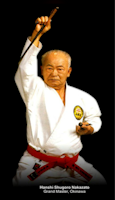 Shugoro Nakazato Hanshi Judan (August 14, 1920 - August 24, 2016)
has spent most of his life in the martial arts and, in 1967, after
nearly twenty years of training was awarded 9th Degree Hanshi by his own
Sensei, Chibana Chosin. Upon Chibana's death in 1969, Nakazato Hanshi
became the president of the Okinawa Shorin Ryu Shorinkan Karate Do
Kyokai and was promoted to 10th Dan Hanshi. Nakazato Hanshi is on of the
most influential Karate Grand Masters in the world and highly regarded
as one of the best in Okinawa of all time. During his lifetime he
traveled the world promoting the benefits and aspects of authentic
Okinawan Karate (Dento). Nakazato Hanshi was the head of the Okinawan
Karate delegation that came to the United States promoting the first
Okinawa Traditional Karatedo and Kobuo World Championships. In 1996, at
the Olympic Games in Atlanta, Georgia, Nakazato Hanshi led the
presentation of Okinawan Karate to the world!
Shugoro Nakazato Hanshi Judan (August 14, 1920 - August 24, 2016)
has spent most of his life in the martial arts and, in 1967, after
nearly twenty years of training was awarded 9th Degree Hanshi by his own
Sensei, Chibana Chosin. Upon Chibana's death in 1969, Nakazato Hanshi
became the president of the Okinawa Shorin Ryu Shorinkan Karate Do
Kyokai and was promoted to 10th Dan Hanshi. Nakazato Hanshi is on of the
most influential Karate Grand Masters in the world and highly regarded
as one of the best in Okinawa of all time. During his lifetime he
traveled the world promoting the benefits and aspects of authentic
Okinawan Karate (Dento). Nakazato Hanshi was the head of the Okinawan
Karate delegation that came to the United States promoting the first
Okinawa Traditional Karatedo and Kobuo World Championships. In 1996, at
the Olympic Games in Atlanta, Georgia, Nakazato Hanshi led the
presentation of Okinawan Karate to the world!
In addition, Nakazato Hnashi is credited for the introduction of the Gorin Kata. In August of 2000, the Okinawan Prefectural Board of Education bestowed upon Nakazato Hanshi the title of "Kenmukei Bunkazi" meaning Intangible Cultural Asset. Nakazato Hanshi has trained some of the absolutely best Karate Masters in the world including: Eddie Bethea, Eberhard Welch, Noel Smith, CD Williamson, Tadashi Yamashita and Doug Perry to name just a few.
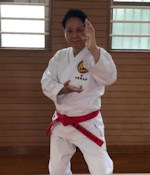 In
August of 2016, Shorinkan members across the world were saddened by the
passing of this cultural Karate icon. A few priors to his passing,
Nakazato Hanshi had the foresight to appoint his son,
Minoru Nakazato,
as the head of the Shorin Ryu Shorinkan Association. Minoru Nakazato
Hanshi has brought a youthful and energetic presence to members of the
Shorinkan across the world. He often points fine details found within
the Kata, Bunkai and methods of Shorinkan as a way of Self Defense.
Minoru Nakazato Hanshi has been very active in the development and
promotion of Okinawan Karate along with assisting in overseeing the new
Karate Kaikan (Karate Hall) built in Okinawa. Most recently Minoru
Nakazato Hanshi was appointed President of the Okinawan Karate-Do Kobudo
Association.
In
August of 2016, Shorinkan members across the world were saddened by the
passing of this cultural Karate icon. A few priors to his passing,
Nakazato Hanshi had the foresight to appoint his son,
Minoru Nakazato,
as the head of the Shorin Ryu Shorinkan Association. Minoru Nakazato
Hanshi has brought a youthful and energetic presence to members of the
Shorinkan across the world. He often points fine details found within
the Kata, Bunkai and methods of Shorinkan as a way of Self Defense.
Minoru Nakazato Hanshi has been very active in the development and
promotion of Okinawan Karate along with assisting in overseeing the new
Karate Kaikan (Karate Hall) built in Okinawa. Most recently Minoru
Nakazato Hanshi was appointed President of the Okinawan Karate-Do Kobudo
Association.
 Eddie
Bethea Kyoshi is an 8th Degree Black Belt and a direct student of
Shugoro Nakazato Hanshi and Minoru Nakazato Hanshi. He is recognized as
one of the few 1st generation black belts in the Shorinkan and has
extensively traveled the world promoting, training and improving Karate
for thousands of people. As part of the "Magnificent Seven", the first
black belts authorized to teach Shorinkan in the United States, Bethea
Kyoshi is considered one of the absolute best martial artists in the
world. Bethea Kyoshi's training began as a member of the US Airforce
while stationed in Okinawa in 1966. He credits his Karate training at
giving him a new found passion in life, discipline to achieve many great
things and so much more.
Eddie
Bethea Kyoshi is an 8th Degree Black Belt and a direct student of
Shugoro Nakazato Hanshi and Minoru Nakazato Hanshi. He is recognized as
one of the few 1st generation black belts in the Shorinkan and has
extensively traveled the world promoting, training and improving Karate
for thousands of people. As part of the "Magnificent Seven", the first
black belts authorized to teach Shorinkan in the United States, Bethea
Kyoshi is considered one of the absolute best martial artists in the
world. Bethea Kyoshi's training began as a member of the US Airforce
while stationed in Okinawa in 1966. He credits his Karate training at
giving him a new found passion in life, discipline to achieve many great
things and so much more.
He currently holds the rank of 8th Dan Kyoshi and is one of the primary leaders of Shorinkan in the United States. His competitive career spans over 4 decades with 3 World Grand Championship titles and 10 World Karate Champion division titles. Bethea Kyoshi is a highly esteemed member of the Trias International Society, the Professional Karate Commission Elite, USKK Budo Society and the USAMA Hawke's Society!

